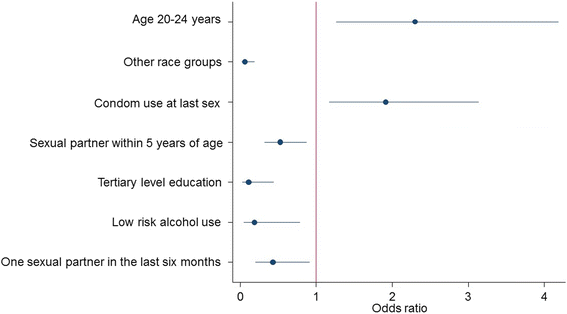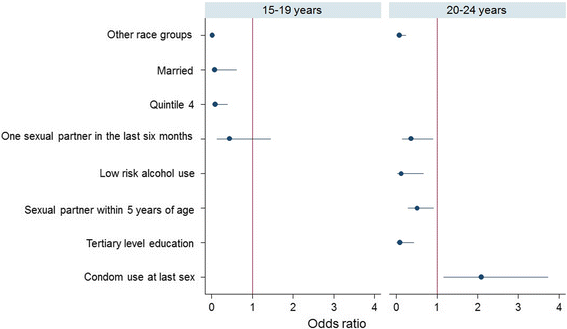Determinants of HIV infection among adolescent girls and young women aged 15-24 years in South Africa: a 2012 population-based national household survey
- PMID: 29373958
- PMCID: PMC5787232
- DOI: 10.1186/s12889-018-5051-3
Determinants of HIV infection among adolescent girls and young women aged 15-24 years in South Africa: a 2012 population-based national household survey
Abstract
Background: South Africa is making tremendous progress in the fight against HIV, however, adolescent girls and young women aged 15-24 years (AGYW) remain at higher risk of new HIV infections. This paper investigates socio-demographic and behavioural determinants of HIV infection among AGYW in South Africa.
Methods: A secondary data analysis was undertaken based on the 2012 population-based nationally representative multi-stage stratified cluster random household sample. Multivariate stepwise backward and forward regression modelling was used to determine factors independently associated with HIV prevalence.
Results: Out of 3092 interviewed and tested AGYW 11.4% were HIV positive. Overall HIV prevalence was significantly higher among young women (17.4%) compared to adolescent girls (5.6%). In the AGYW model increased risk of HIV infection was associated with being young women aged 20-24 years (OR = 2.30, p = 0.006), and condom use at last sex (OR = 1.91, p = 0.010), and decreased likelihood was associated with other race groups (OR = 0.06, p < 0.001), sexual partner within 5 years of age (OR = 0.53, p = 0.012), tertiary level education (OR = 0.11, p = 0.002), low risk alcohol use (OR = 0.19, p = 0.022) and having one sexual partner (OR = 0.43, p = 0.028). In the adolescent girls model decreased risk of HIV infection was associated with other race groups (OR = 0.01, p < 0.001), being married (OR = 0.07), p = 0.016], and living in less poor household (OR = 0.08, p = 0.002). In the young women's models increased risk of HIV infection was associated with condom use at last sex (OR = 2.09, p = 0.013), and decreased likelihood was associated with other race groups (OR = 0.17, p < 0.001), one sexual partner (OR = 0.6, p = 0.014), low risk alcohol use (OR = 0.17, p < 0.001), having a sexual partner within 5 years of age (OR = 0.29, p = 0.022), and having tertiary education (OR = 0.29, p = 0.022).
Conclusion: These findings support the need to design combination prevention interventions which simultaneously address socio-economic drivers of the HIV epidemic, promote education, equity and access to schooling, and target age-disparate partnerships, inconsistent condom use and risky alcohol consumption.
Keywords: Adolescent girls; Determinants; HIV infection; South Africa; Young women.
Conflict of interest statement
Ethics approval and consent to participate
The survey protocol was approved by the Human Sciences Research Council’s Research Ethics Committee (REC: 5/17/11/10) as well as by the Associate Director of Science of the National Centre for HIV and AIDS, Viral Hepatitis, STD and TB Prevention at the USA’s Centers for Disease Control and Prevention (CDC) in Atlanta Participants were informed of the purpose of the study. All participants provided written informed consent. Participants were guaranteed anonymity and all questionnaires and blood samples were only linked using a unique barcode.
Consent for publication
Not applicable.
Competing interests
The authors declare that they have no competing interests.
Publisher’s Note
Springer Nature remains neutral with regard to jurisdictional claims in published maps and institutional affiliations.
Figures


References
-
- UNAIDS . HIV prevention among adolescent girls and young women: putting HIV intervention among adolescent girls and young women on the fast-track and engaging men and boys. Geneva: UNAIDS; 2016.
-
- UNAIDS . Global AIDS update 2016: fast-tracking the response in eastern and southern Africa – focus on Adolescent Girls & Young Women. Global AIDS update 2016, and prevention gap report, UNAIDS, Geneva; 2016. Geneva: UNAIDS; 2015.
-
- Shisana O, Rehle T, Simbayi LC, Zuma K, Jooste S, Zungu N, et al. South African national HIV prevalence, incidence and behavior survey, 2012. Cape Town: HSRC Press; 2014. - PubMed
-
- Niëns L, Lowery D. Gendered epidemiology: sexual equality and the prevalence of HIV/AIDS in sub-Saharan Africa. Soc Sci Q. 2009;90(5):1134–1144. doi: 10.1111/j.1540-6237.2009.00650.x. - DOI
Publication types
MeSH terms
Grants and funding
LinkOut - more resources
Full Text Sources
Other Literature Sources
Medical

